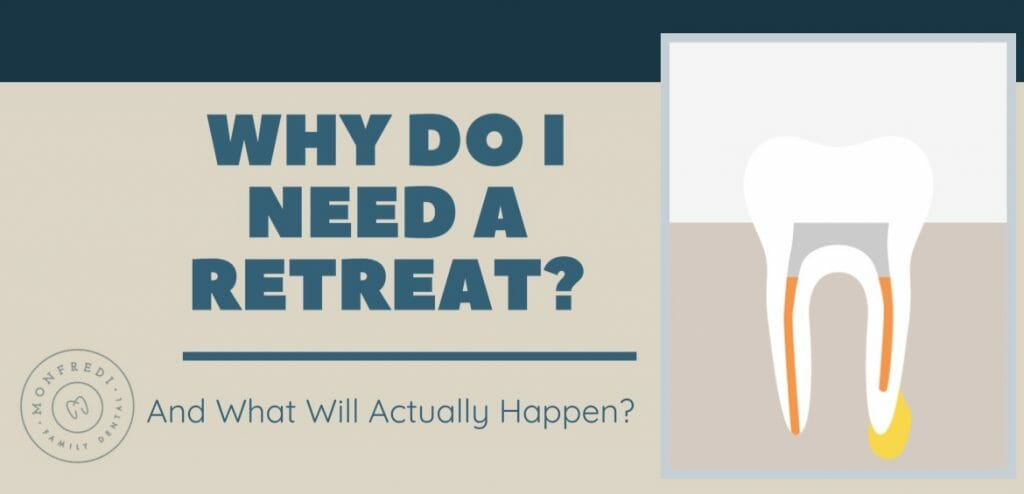
Sometimes – rarely – a root canal doesn’t work the first time. Unfortunately, this ‘not working’ can present itself anywhere from days after the original root canal to years later. And when that happens, a common solution to fix the problem is to perform a retreat root canal.
What is a retreat root canal and why will I need one?
When we do an original root canal, we go in from the top of the tooth (the crown) to open up and clean out the chambers and canals. During this process, we remove all nerve tissue and all of the bacteria present within the canals and then seal the canals and the tooth so that no additional bacteria can enter.
Sometimes the canal or chamber can become re-infected. This can either happen from the bottom of the tooth near the root or through the crown of the tooth where we placed the original restoration. Many times, when the infection reenters from the top of the tooth, that is because the restoration originally placed wasn’t sealed perfectly well.
Either way, when bacteria reenters the canal, you’ll need to either have a retreat root canal or have the tooth extracted. And as we’ll often say that the best solution is to keep as many healthy original teeth in your mouth as possible, Dr. Monica will often recommend a retreat in these cases.
How will I know that I may need a retreat root canal?
If you are experiencing pain on a tooth that has previously had a root canal or if you have an abscess (a swollen area of your gums), these are tell-tale signs a retreat may be needed.
It is also important to note that many abscesses start small and can remain unnoticed because they are not presenting with pain in your mouth. This is another reason why keeping your regular 6-month dental visits and monitoring root canal treated teeth with X-rays is so vital to your overall and oral health.
Is a retreat much different than the original root canal?
The process for you – the patient – isn’t much different at all. Dr. Monica does have a slightly different responsibility though. Instead of removing the nerve, like in an original root canal, she’ll be removing the filling material that was placed initially. The one constant is that whether she’s performing an original root canal or a retreat, the goal is to remove all of the bacteria. This is the main reason why your pain (if you have it) will subside.
Do I need a retreat because my dentist didn’t do a good job the first time around?
Not always. We like to think that root canals are an exact science, however, it’s more like an art form. And as we’ve written about previously, Dr. Monica has even had to have a retreat done in her own mouth (as well as multiple fillings, crowns, root canals, oh and a surgery where they cut off her jaws and reattached them…) So really, it’s nothing that she hasn’t been through before and she’s quick to say that this art form can be a tricky one to perfect – depending on the tooth and its unique anatomy.
At times, teeth can have more or fewer canals than are expected. Also, canals can branch into multiple other canals. In Dr. Moinca’s case, there was one canal missed during her original root canal, and a few years later when the infection returned and her specialist reopened the tooth, he found the additional canal.

Did that experience turn her away from her endodontist?
She said, “That was a specialist that I highly trust and have a ton of confidence in. If I need another root canal done, he’d be the one I would schedule with.” So, while these things can happen sometimes, it is not necessarily because your dentist didn’t do a good job. Retreats can happen even to the most highly-trained specialists.
Is a root canal retreatment something we would do at MFD?
While Dr. Monica does perform some retreats at our office, we will refer many retreat cases to a specialist. Endodontists (the specialists) have much more experience in performing both retreats and original root canals and because they do these procedures every day, they can be a great resource when needed.
If my tooth becomes reinfected and I get a retreat, is there a chance I would need a 2nd retreat at some point?
Dr. Monica answered, “I’m not going to say never because there’s always that possibility but usually if we found the source of why it became infected for a second time (a missed canal, the crown wasn’t properly sealed, or the tooth wasn’t fully filled, etc…) then usually the retreat will be successful.”
If the retreat isn’t successful, Dr. Monica will typically recommend that the tooth be extracted.
After the retreat is complete, what will I need to do to keep my tooth strong?
You’ll need a final restoration in the tooth, whether that’s a filling or a crown. Usually, this is a crown but in some cases (normally with front teeth) it can be a filling. If the retreat is performed on a tooth that already has a crown and that crown hasn’t broken during the retreat, we can seal the crown with a filling as your final restoration.
In some cases, the original crown will break during your procedure, but this is not the most common outcome. If that happens, you will need a new crown to protect your tooth.
While retreats aren’t the desired outcome after root canals, they are a viable option
As Dr. Monica put it, “I’m living proof… I’ve had it done in my own mouth. It’s been 6 years since my retreat and the tooth is still in great shape. So this procedure can buy you time and help keep your original teeth in your mouth.”


Had root canal approximately 20 years ago, and placed a porcelain crown on #5 tooth.
Porcelain crown broke (portion).
Now dentist is telling me I need a Retreat on the Root Canal, because it was done years ago, was the old way of doing it, and I need to have a better root canal.
My tooth does not hurt, there is no pain — Do I actually need the retreat or is this just generating $$ for another dentist?
I found this info very informative ,I’m a retired RDA oral surgery assistant. and will be getting a retreat next week on #18 ,many of my questions were answered . Thank you
I too like the comment above, will be going in to see an Endo specialist to have #18 evaluated for possible retreat. The current crown/ root canal was done in Spring 2008. Very informative. Thank you
If only the retreat was free of charge considering the job wasn’t done right the first time by the dentist.
husband had infected root canal. migraine headaches for almost a month. Endodontist drilled and fixed it and said he should feel better soon but still in major pain – like pull the tooth out pain. What should we do next? Not big on meds 24/7
I’ve had a root canal 20 years ago. Right now I am having a problem with a tooth that is next to the tooth that has had the root canal, The gums are a little swollen near the root canal tooth, Dentist wants to send me to an Endodontist, she thinks I may need a retreat. I assume it’s from the truth I’m having an issue with right now, she has prescribed an antibiotic . Would it be possible for a root canal that was done 20 years ago to not have been done properly. I would Think I would have had an issue with the root canal tooth much sooner
I just had a retreat of a root canal that was done 8 yrs ago on a molar. Dentist drilled through the crown, even though it was in good condition. Wants me to have a permanent filling instead of another crown. What is the likelihood of a retreat failure? Should I ask for a crown instead?
So nice to sit at home, not stressed and be able to read information I need. Thanks so much.
I have to retreat an old route canal. I have to redo #16, I don’t have any pain with the tooth, but I do have decay which is why I have to have it worked on (Take out the fillings from the first route canal and then refill it/clean area). Unfortunately, my insurance doesn’t cover the retreatment of the route canal.
Always allow your dentist to take x-rays, and follow your dentist’s recommendation regarding referral to an endodontist. Since nerve tissue is removed from a root canal, more often than not, you won’t be able to tell if you have an infection until the abscess is large enough to cause generalized discomfort. Getting retreatment is essential because the abscess over time can leach toxins into your system and cause all sorts of weird symptoms, including confusion, mental fog and even OCD. Though this may seem strange, it is known that inflammation can cause these things, and an abscess is a source of poison.
I suffered for years with these symptoms not knowing I had a chronic tooth infection, until it got really bad. Once I got retreatment and was on a regimen of oral antibiotics as well as a calcium hydroxide antibacterial paste placed inside the root canals, these symptoms have dramatically decreased. I return for finalizing treatment in a month.
Don’t let something like this go untreated, as it can literally save your mind AND your life. It’s this serious.
I need a retreat as there is an infection, have had 3 abscesses so far and the root has very little bone and I was told if there is a crack in it even after the retreat I would have to have the tooth removed. Any advice?